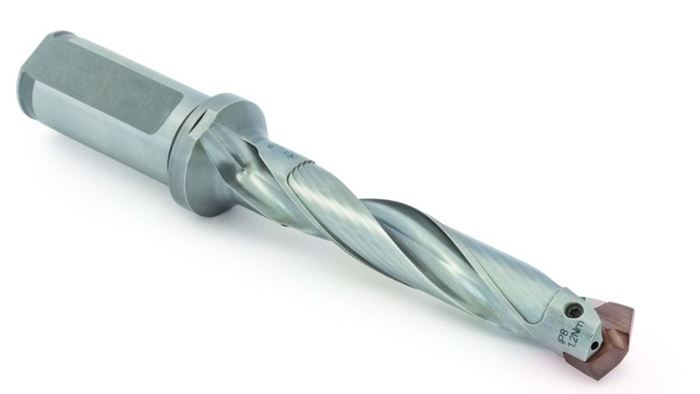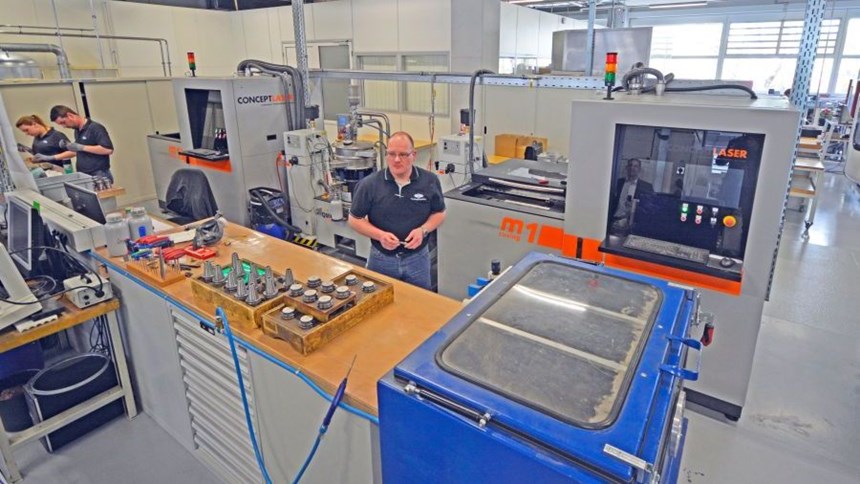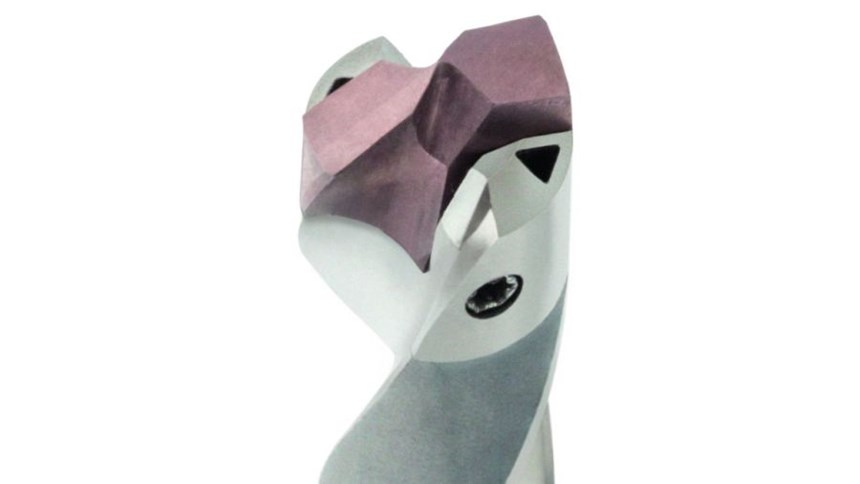Additive Manufacturing Makes Subtractive Cutting Tools
Cutting tool manufacturer Mapal leveraged additive technology to produce smaller versions of its through-coolant insert drills.
Because additive manufacturing is sometimes seen as an alternative to conventional manufacturing, using AM to produce subtractive cutting tools may seem counterintuitive. However, AM’s value often comes not in replacing an existing process, but in opening up a design possibility that would not otherwise be practical or possible. Cutting tool manufacturer Mapal’s use of AM to expand its line of through-coolant drills illustrates this perfectly. The company was able to create smaller versions of its through-coolant QTD drills using laser melting systems from Concept Laser.
Mapal, based in Aalen, Germany, produces precision cutting tools used in automotive machining and other production metalworking applications. The company offers its insertable QTD drills with through-coolant capability as an economical alternative to solid carbide drills. Each drill in this line consists of a hardened steel shank and body with a V-block mounting for the replaceable insert. According to Mapal, the through-coolant drills offer good chip deformation and reliable chip removal for drilling in steel, stainless steel, cast iron and aluminum.
Until recently, these drills were only offered in diameters of 13 mm or greater because of restrictions in producing their internal geometry. The drills have a central coolant supply channel and a Y-shaped fork that distributes this internal coolant flow to either side of the cutting insert. These passageways are themselves produced through drilling.
While it might have been possible to produce the coolant channels in smaller-diameter drills, two factors prevented it:
- The strength of the drill. The simple presence of the central coolant bore means the drill is already weaker than a solid tool would be. If the tool body is made smaller with this central hole through it, the drill might become unstable.
- The effectiveness of the coolant. Reducing the size of the coolant channels along with the drill body would help preserve the tool’s strength, but this would reduce the rate of coolant flowing to the cutting edge, limiting its effectiveness.
Combined, these restrictions made it impractical to pursue a smaller drill made with the same design and methods.
“From a certain point, it makes no sense to optimize old strategies to the max,” says Dr. Dirk Sellmer, head of Research & Development at Mapal. “You have to try something new.”
Since May 2013, Mapal has been doing just that, investigating how additive manufacturing, specifically selective laser melting, could alleviate the challenges in producing through-coolant tooling. New, smaller QTD drills are the result of this work. Using two M1 LaserCusing systems from Lichtenfels, Germany-based Concept Laser, the company’s R&D department was able to produce QTD drills with an optimized coolant supply design that improves performance while enabling smaller drill diameters.
The M1 LaserCusing machines operate with a powder-bed process that uses a laser to melt specific areas of metal powder, fusing the part together layer by layer. Mapal chose this particular make and model because of its ease of operation and the customization offered by Concept Laser for its applications, the company says. In Mapal’s Aalen R&D facility, the two M1 machines are supplied by a central container filled with standard 1.2709 steel powder.
Using the laser melting technology, the company has developed a new QTD drill with an internal geometry that would not be possible to produce via traditional machining. The laser-melted drills feature a spiral cooling geometry with the coolant channels running parallel to the flute, which increases the core stability and improves cooling effectiveness. According to Dr. Sellmer, the spiral coolant routing is responsible for increasing the drills’ coolant volume flow by 60 percent.
Mapal was also able to change the cross-section of the coolant channels. Rather than the round passageways necessitated by a spinning tool in a spindle, the laser-melted drills feature triangular channels. According to Mapal, the triangular passageways increase the quantity of coolant flow by as much as 30 percent over the previous drills. The combination of spiral routing and the triangular cross-section is said to increase coolant flow rate by 100 percent over the previous design.
In light of these performance advantages from additive manufacturing, “The ability to offer drills with smaller diameters was almost a side effect,” says Dr. Sellmer. The company now produces additively manufactured QTD drills in diameters down to 8 mm. (Drills 13 mm in diameter and larger are still produced conventionally.)
Mapal has not entirely switched to additive manufacturing for its small-diameter QTD drills, however. Rather, the company uses a hybrid process whereby the tool shank is still machined conventionally from case hardened steel, but the drill body is built in a LaserCusing machine from 1.2709 steel in two stages.
“First, the core of an insert drill is built with the cooling system, which is added to the conventional shaft,” explains Dr. Sellmer. “In a second additive run, the outer hull is built up with higher densities, which is close to the ideal for a good drill bit—hard outside and soft inside."
This hybrid process allows Mapal to reap the benefits of speed from traditional machining in making the tool shanks, as well as the material efficiency, unattended production and design benefits of additively manufacturing the drill bodies. The LaserCusing machines enable the company to build the drill bodies onto the shanks in large arrays of 10 × 10 or 11 × 11, completing 100 to 121 drills in one setup.
Mapal is also applying the laser melting technology to other products. For example, the R&D department was able to realize weight savings of more than 50 percent in an external reamer by building it with an internal honeycomb structure. On the workholding side, Mapal’s HighTorque Chuck (HTC) has a 3-degree back taper that is produced additively; the laser melting process allows the clamping range to be positioned close to the chuck tip, and eliminates a soldered joint that once was a limiting factor.
In these applications, as well as the QTD drills, Mapal is not replacing machining with additive manufacturing. Instead, it is using additive to fill existing production gaps and make possible designs that could not be produced any other way.
Related Content
3D Printed Titanium Replaces Aluminum for Unmanned Aircraft Wing Splice: The Cool Parts Show #72
Rapid Plasma Deposition produces the near-net-shape preform for a newly designed wing splice for remotely piloted aircraft from General Atomics. The Cool Parts Show visits Norsk Titanium, where this part is made.
Read MoreThis Drone Bird with 3D Printed Parts Mimics a Peregrine Falcon: The Cool Parts Show #66
The Drone Bird Company has developed aircraft that mimic birds of prey to scare off problem birds. The drones feature 3D printed fuselages made by Parts on Demand from ALM materials.
Read More8 Cool Parts From Formnext 2024: The Cool Parts Show #78
End-use parts found at Formnext this year address various aspects of additive's advance, notably AM winning on cost against established processes.
Read MoreTwo 12-Laser AM Machines at Collins Aerospace: Here Is How They Are Being Used
With this additive manufacturing capacity, one room of the Collins Iowa facility performs the work previously requiring a supply chain. Production yield will nearly double, and lead times will be more than 80% shorter.
Read MoreRead Next
Alquist 3D Looks Toward a Carbon-Sequestering Future with 3D Printed Infrastructure
The Colorado startup aims to reduce the carbon footprint of new buildings, homes and city infrastructure with robotic 3D printing and a specialized geopolymer material.
Read More3D Printed Polymer EOAT Increases Safety of Cobots
Contract manufacturer Anubis 3D applies polymer 3D printing processes to manufacture cobot tooling that is lightweight, smooth and safer for human interaction.
Read MorePostprocessing Steps and Costs for Metal 3D Printing
When your metal part is done 3D printing, you just pull it out of the machine and start using it, right? Not exactly.
Read More
.jpg;width=70;height=70;mode=crop)























